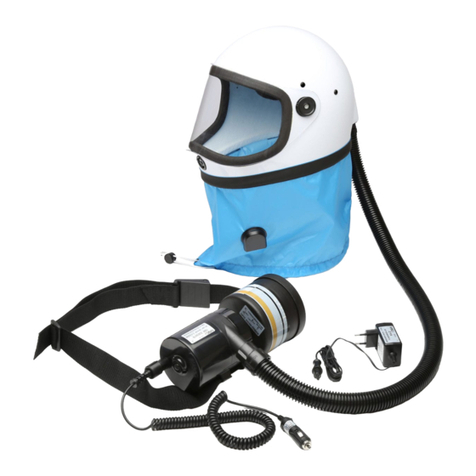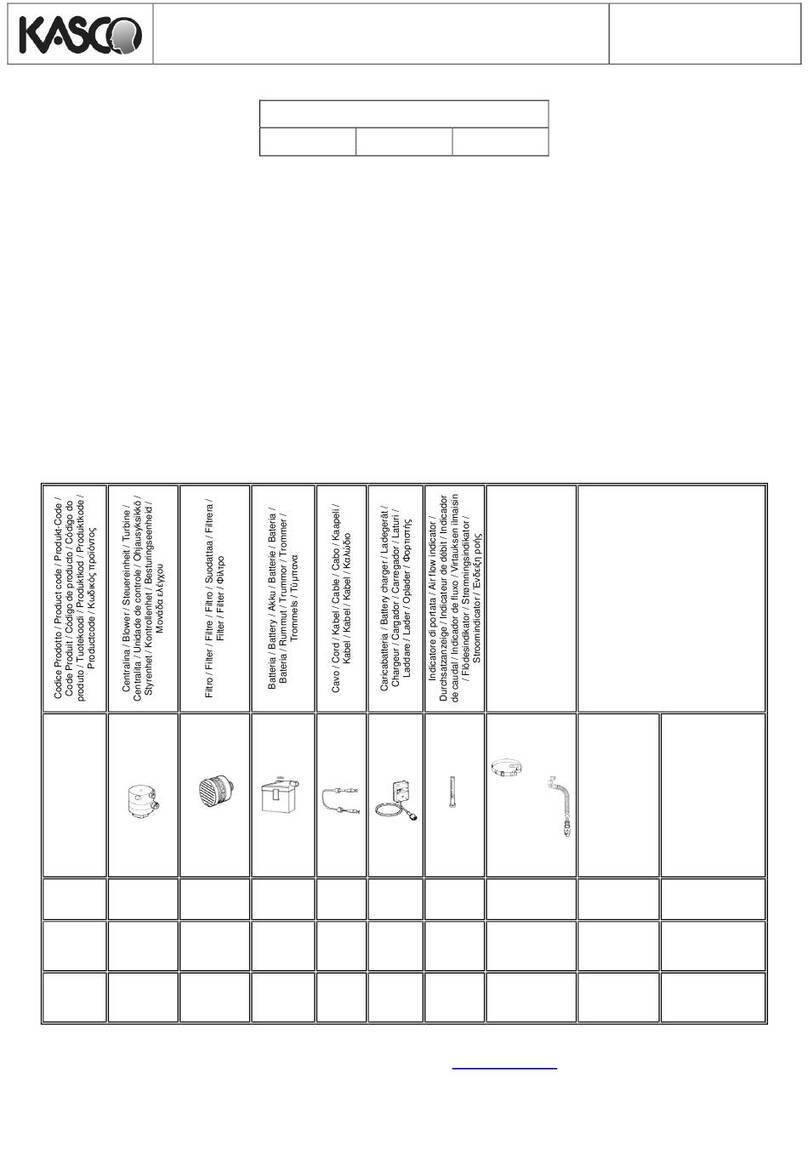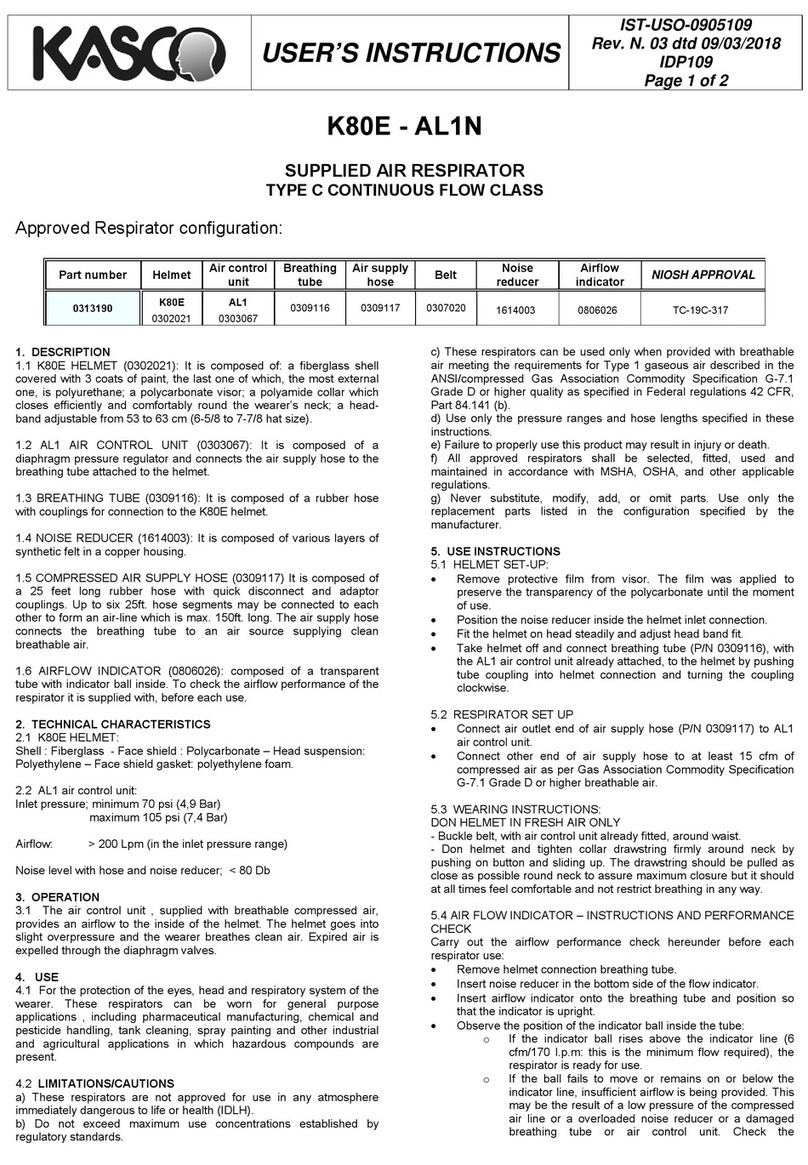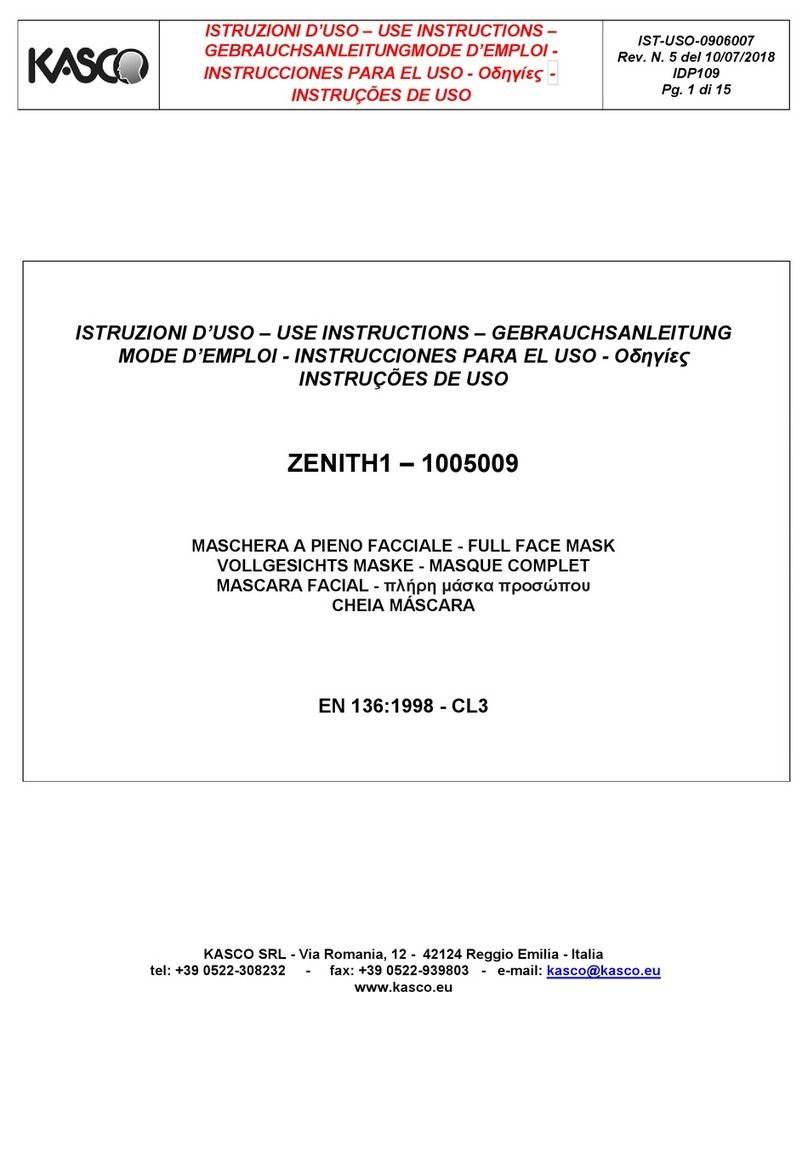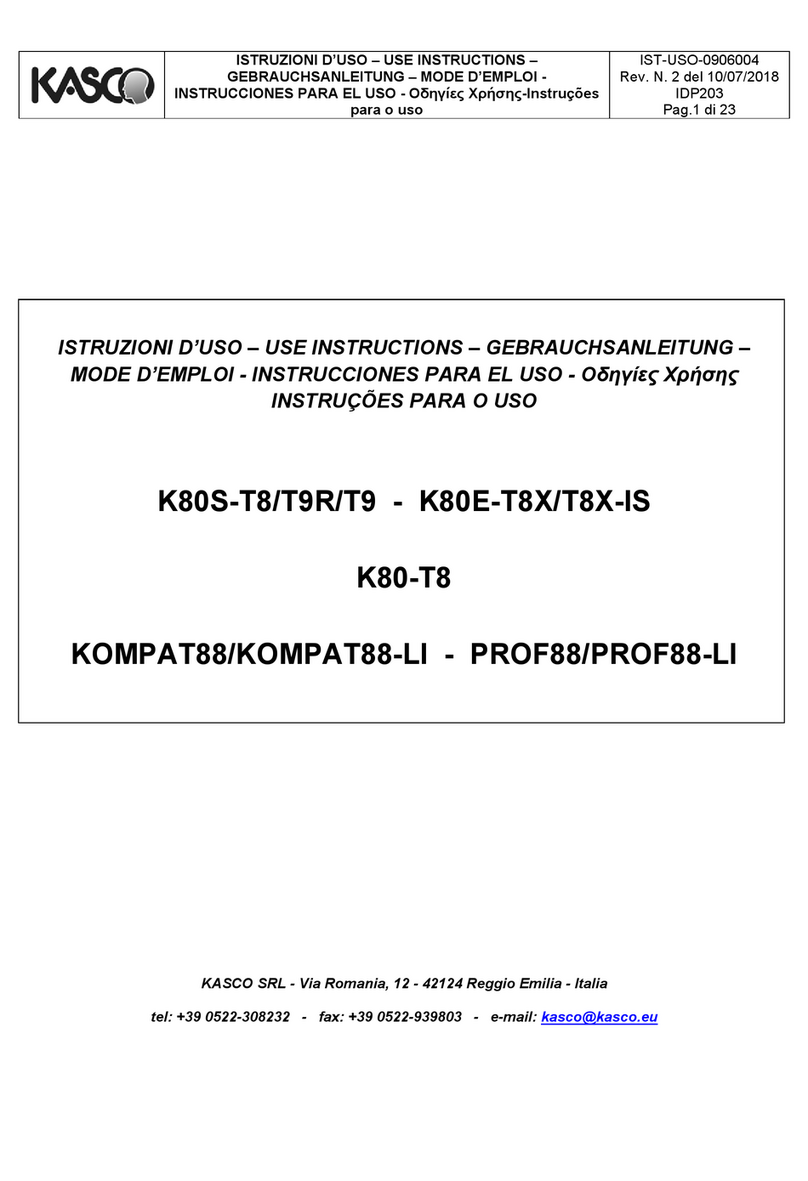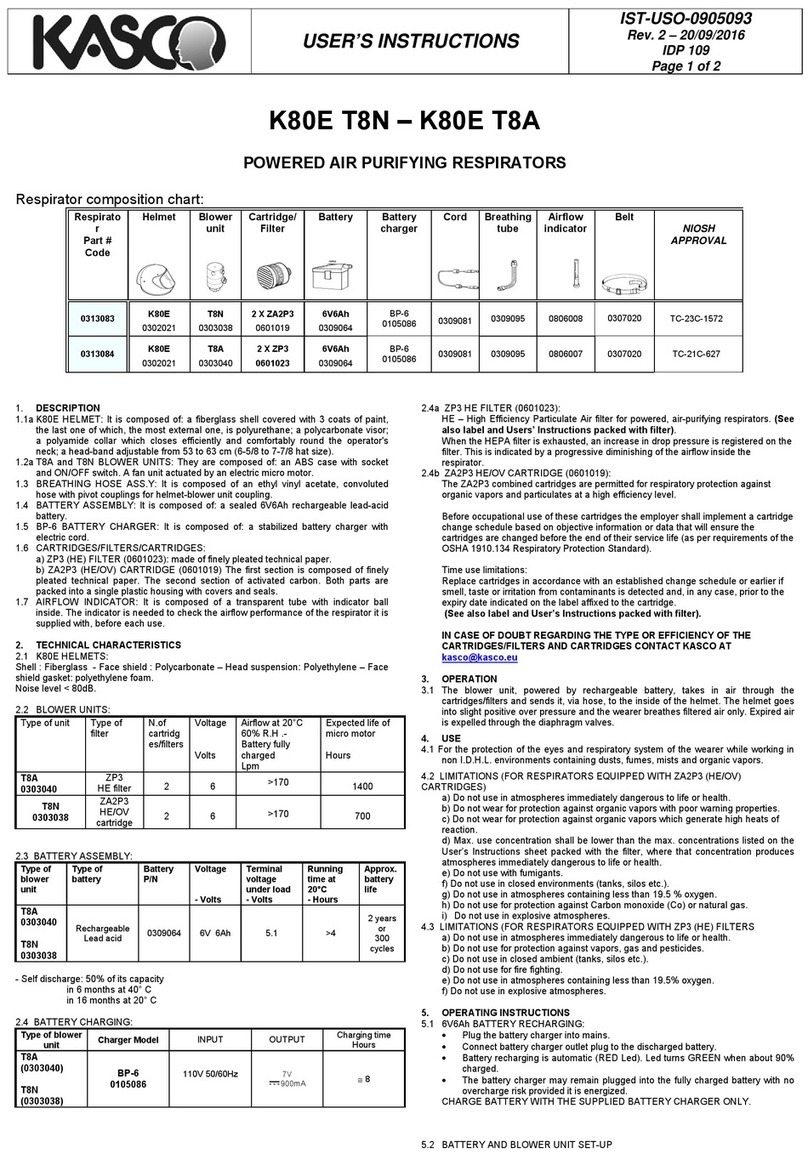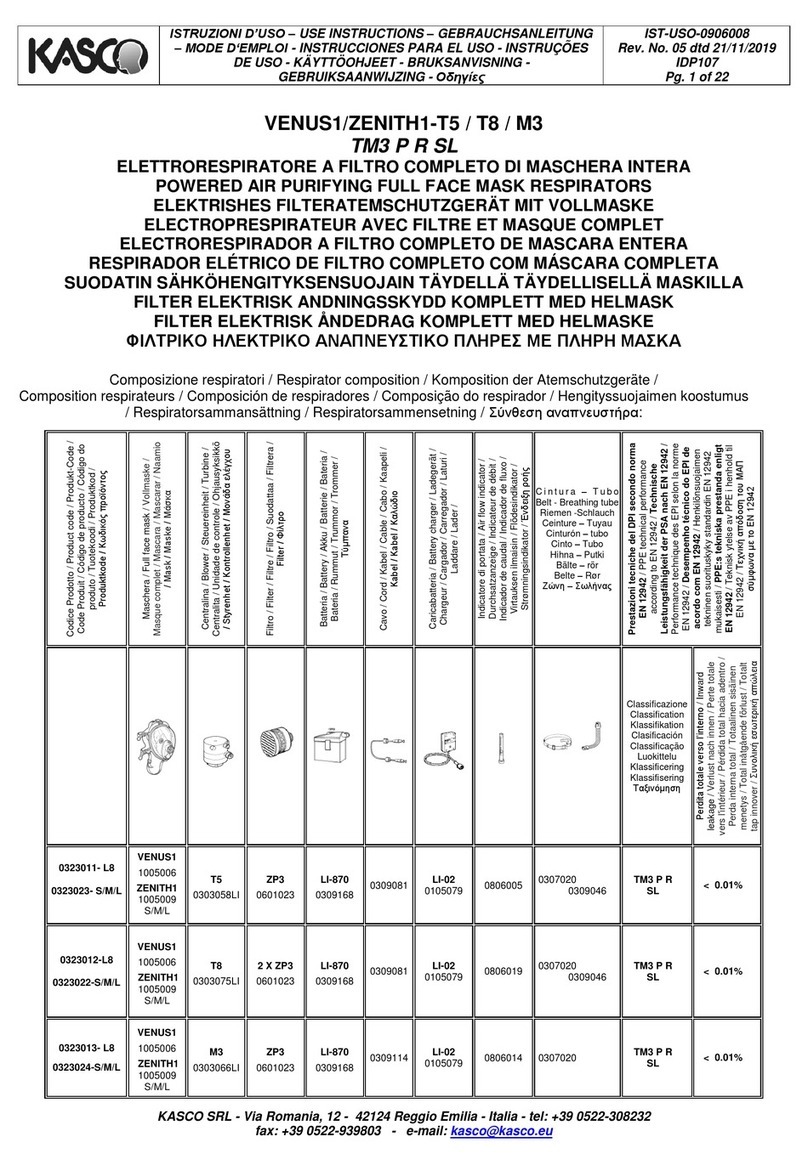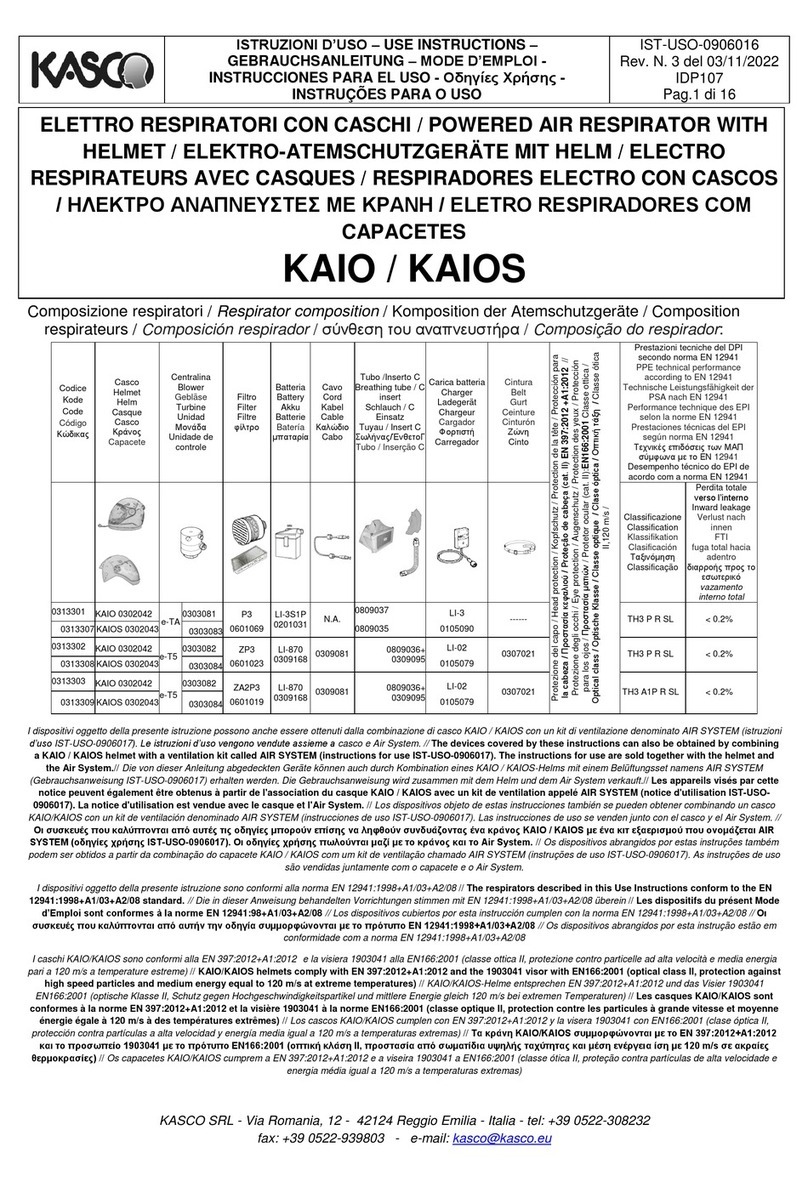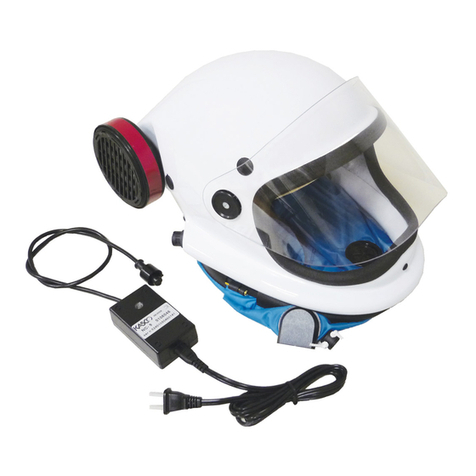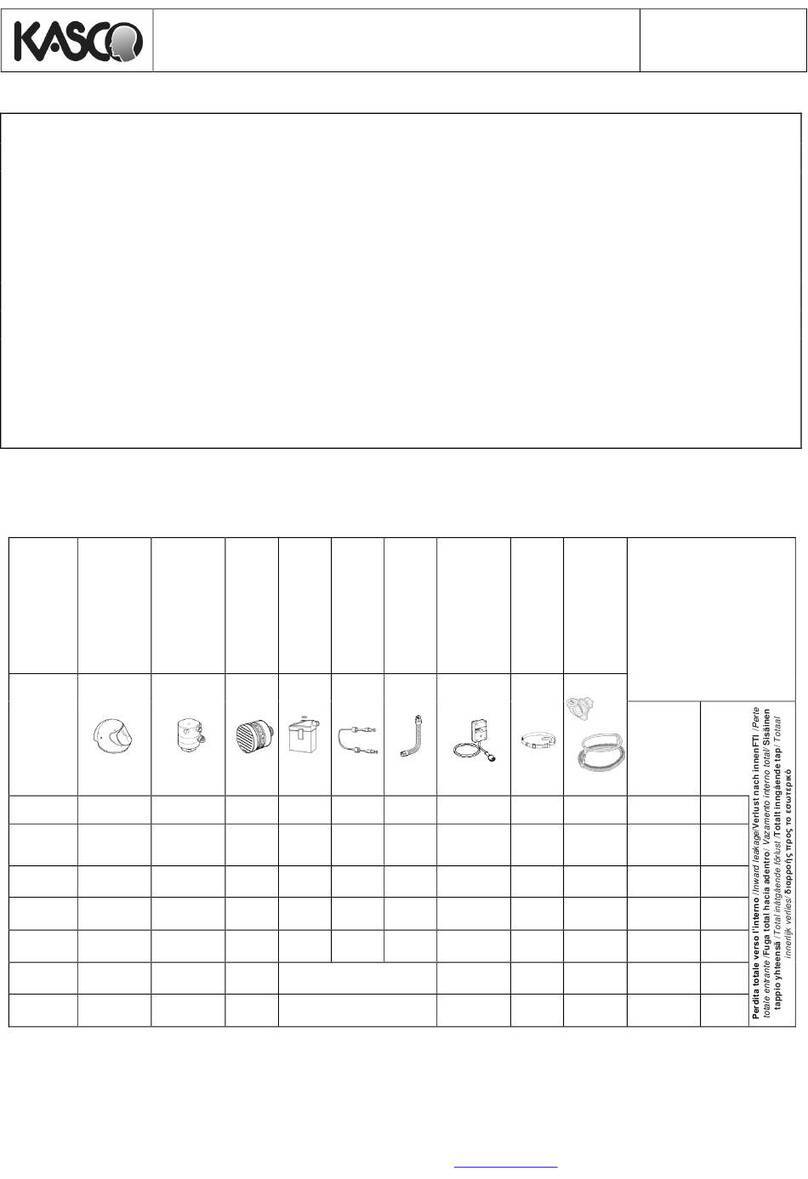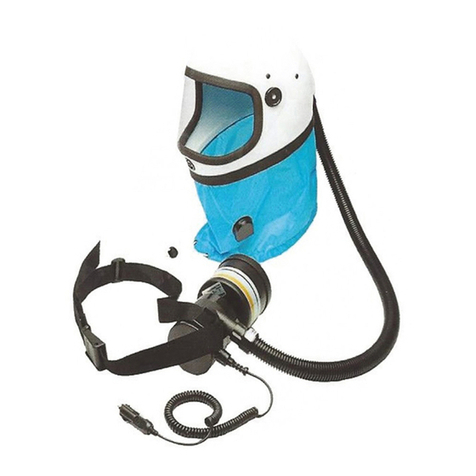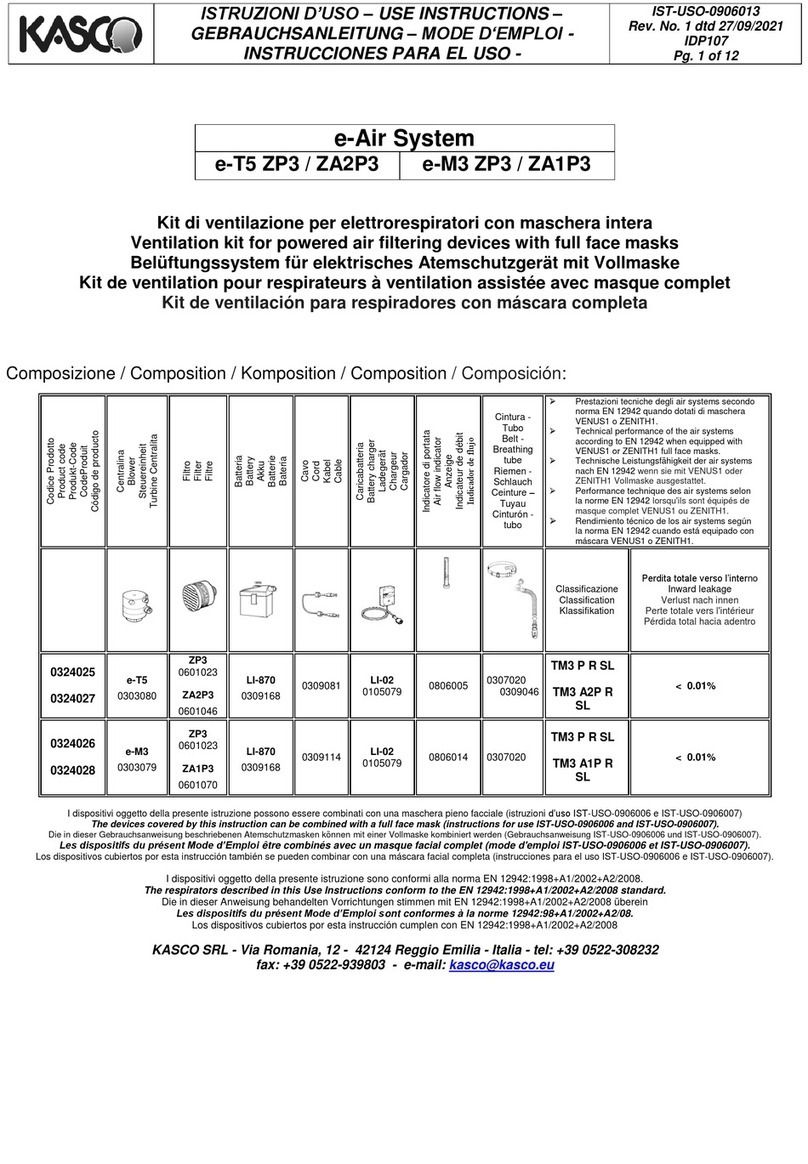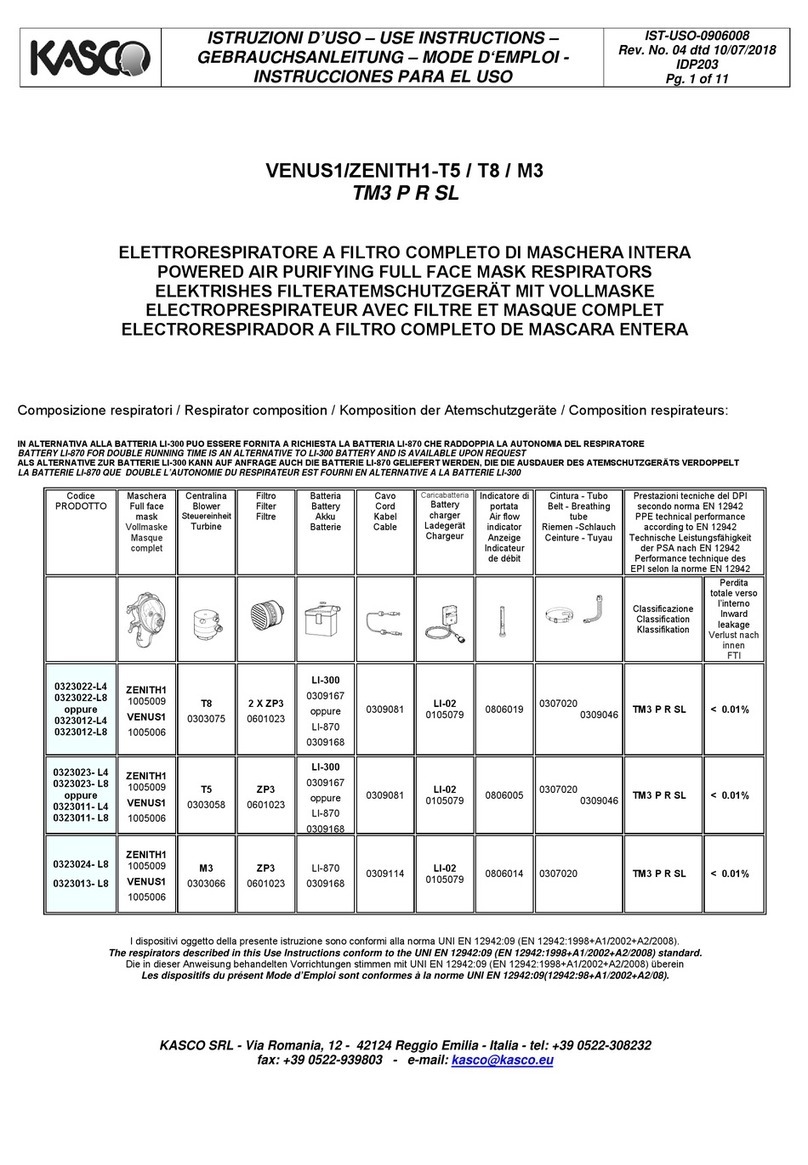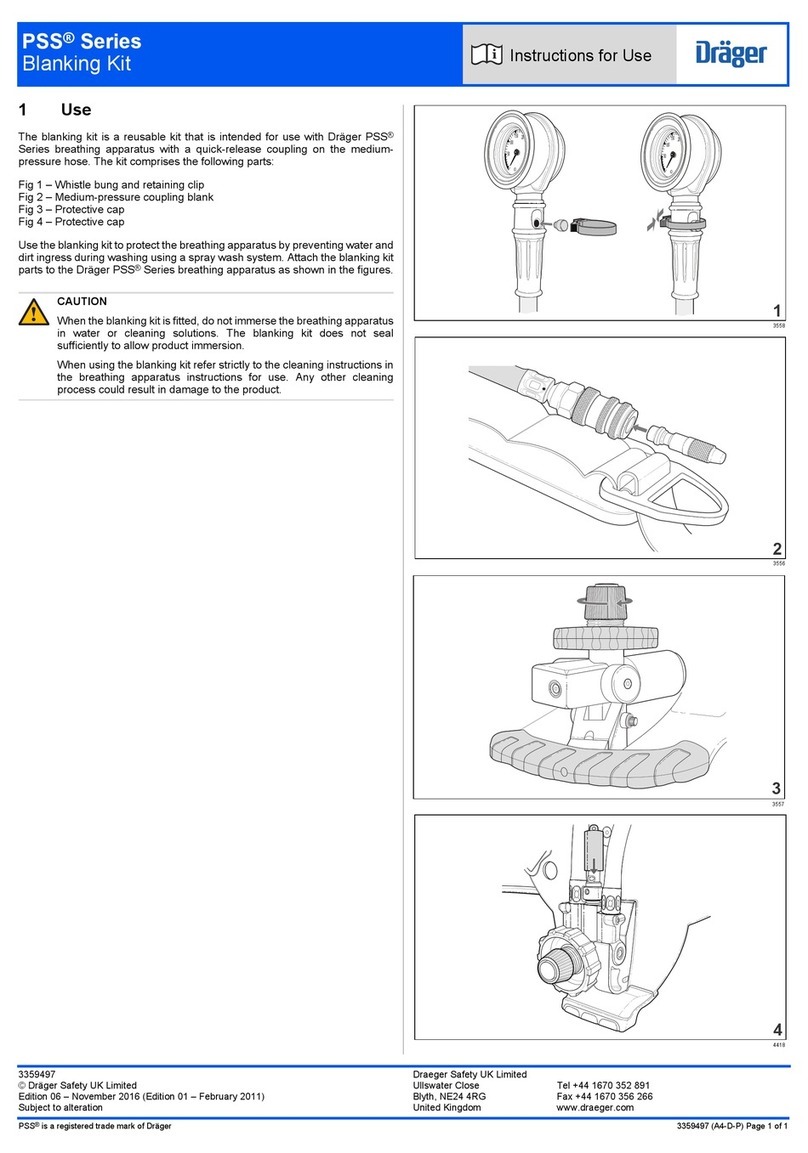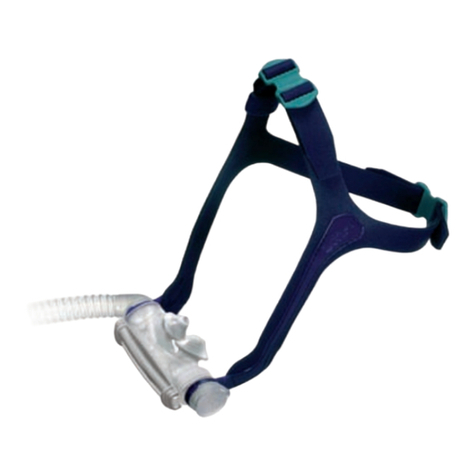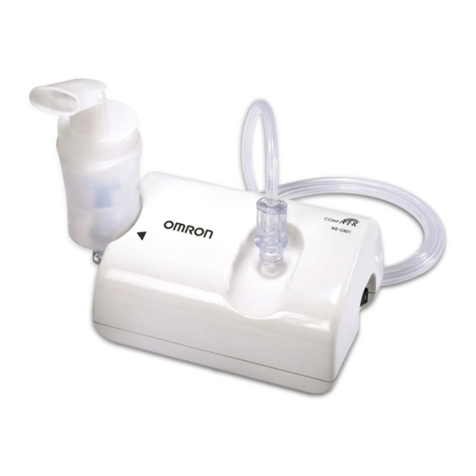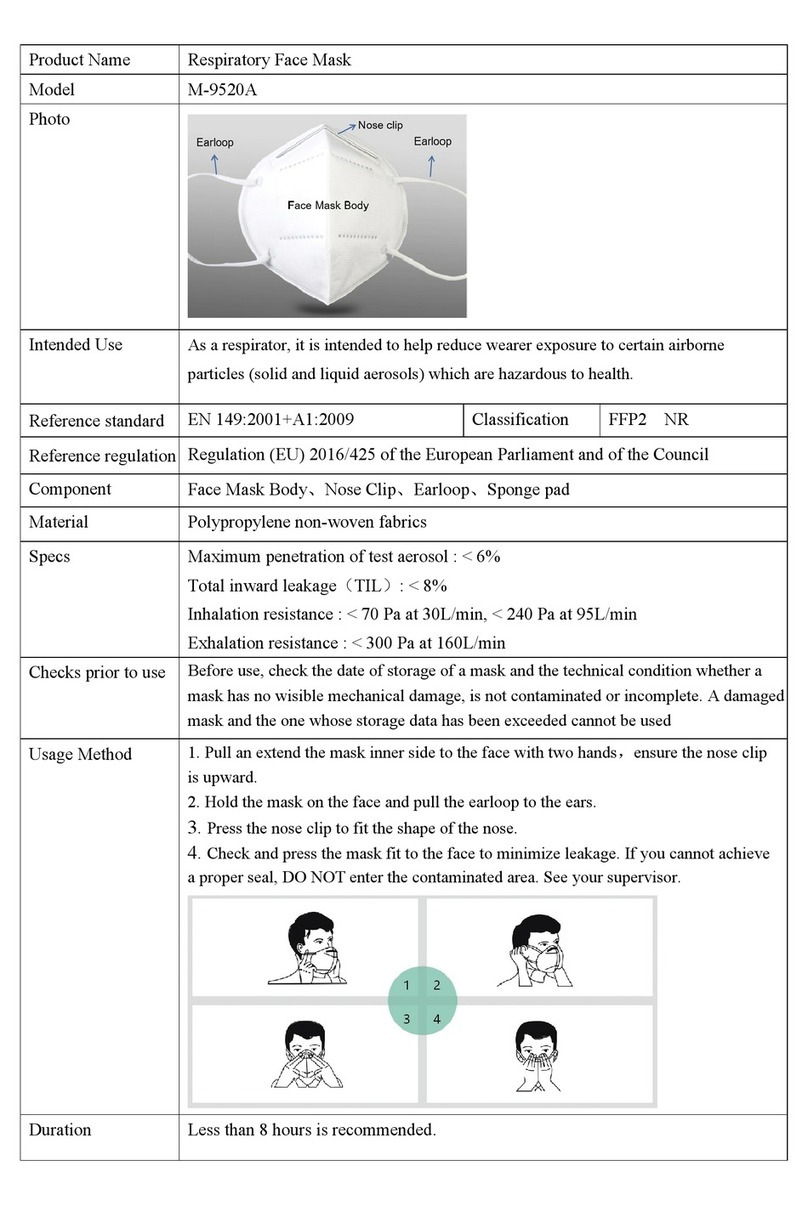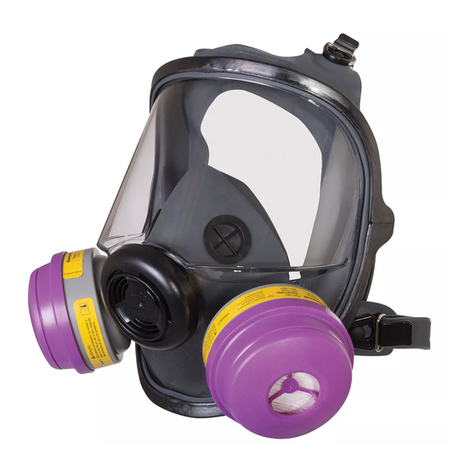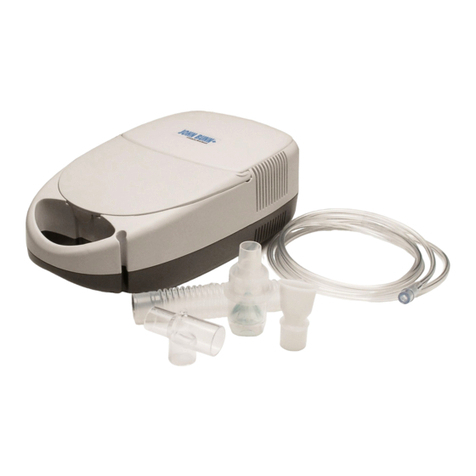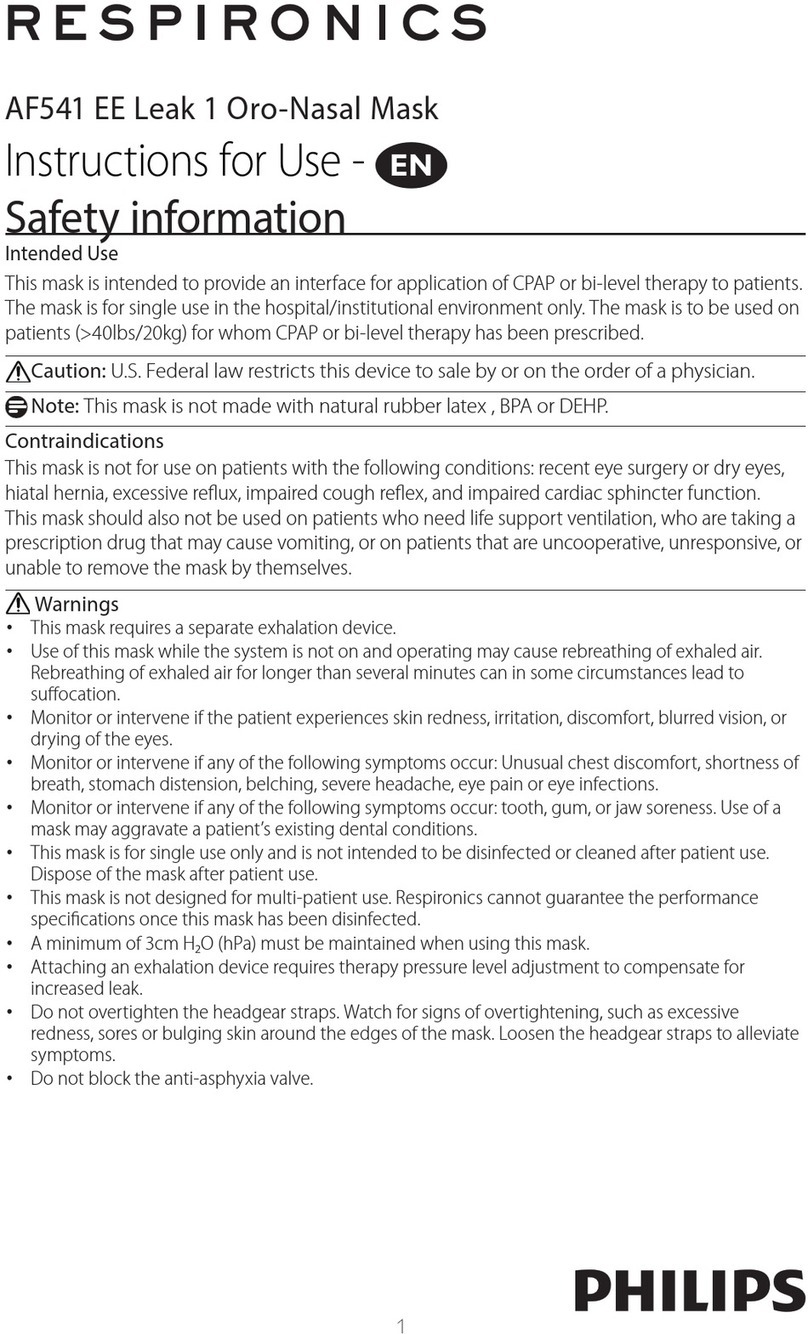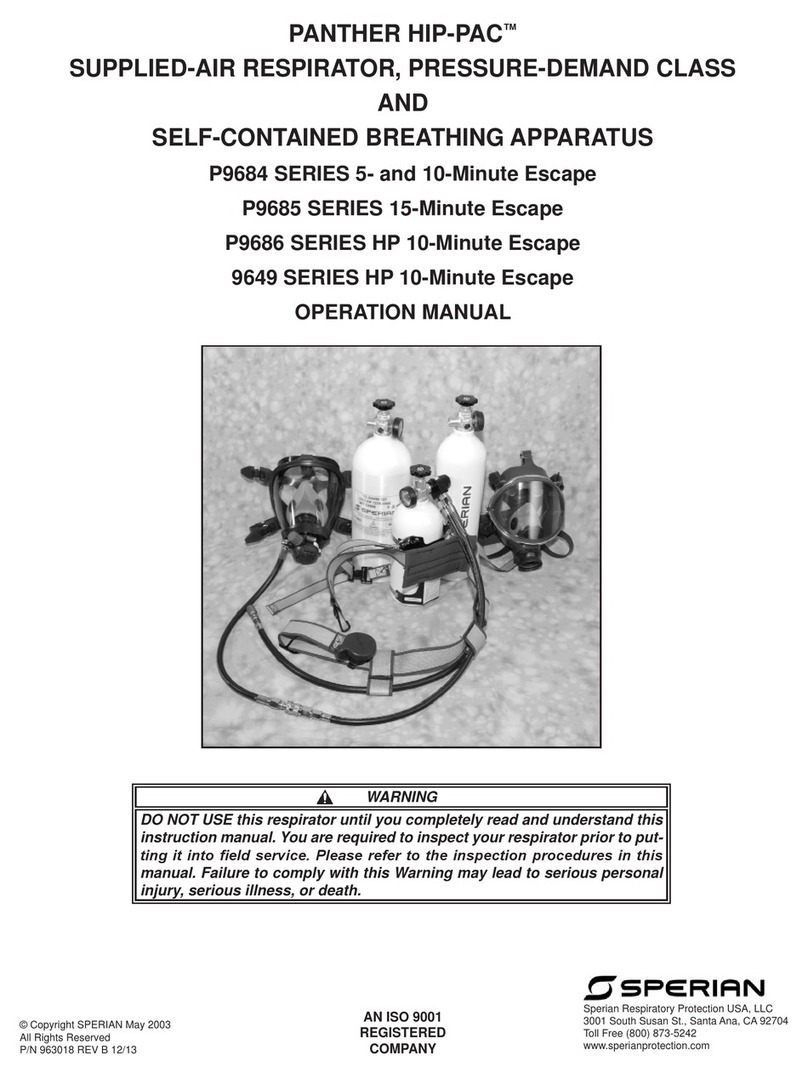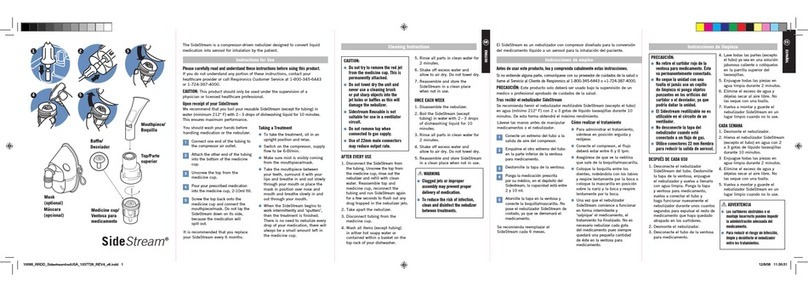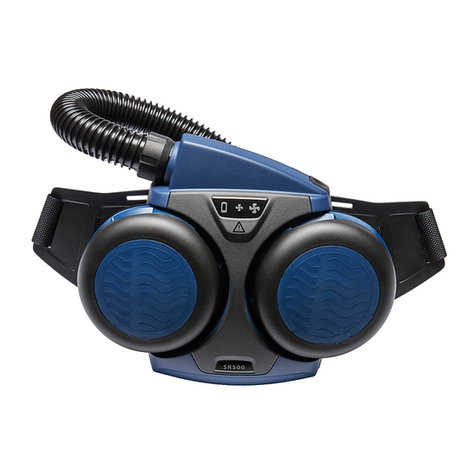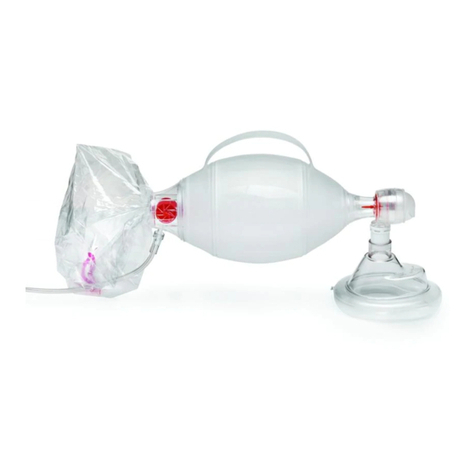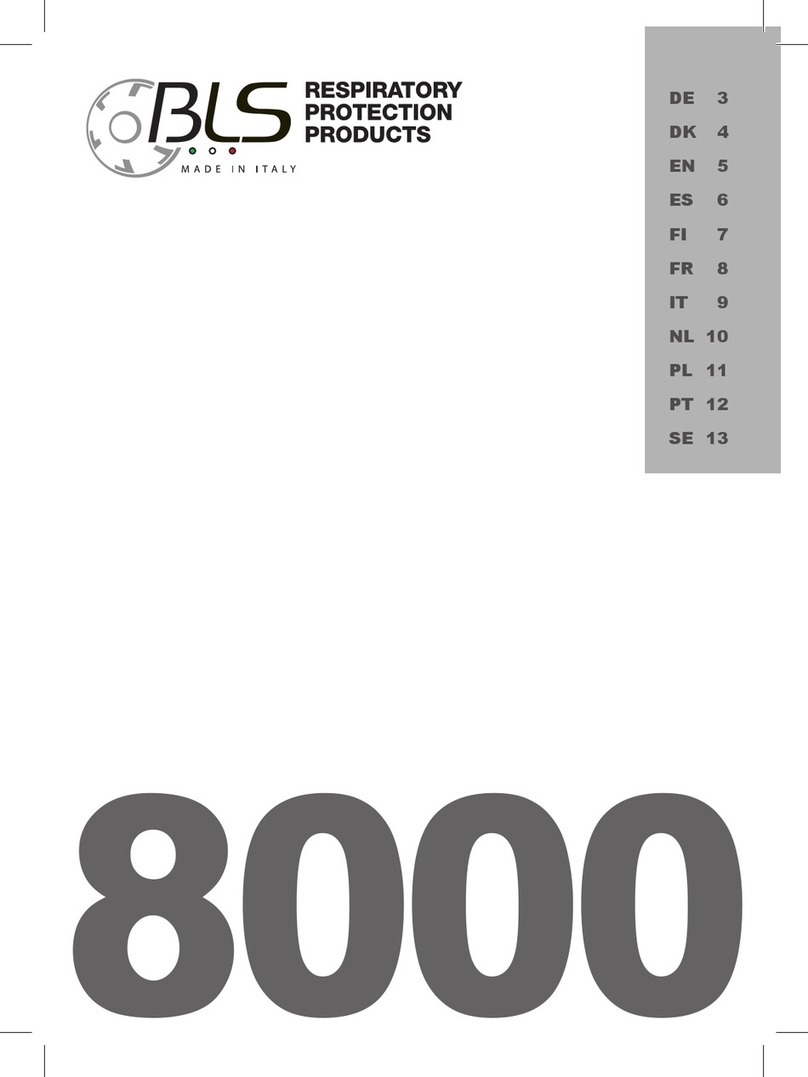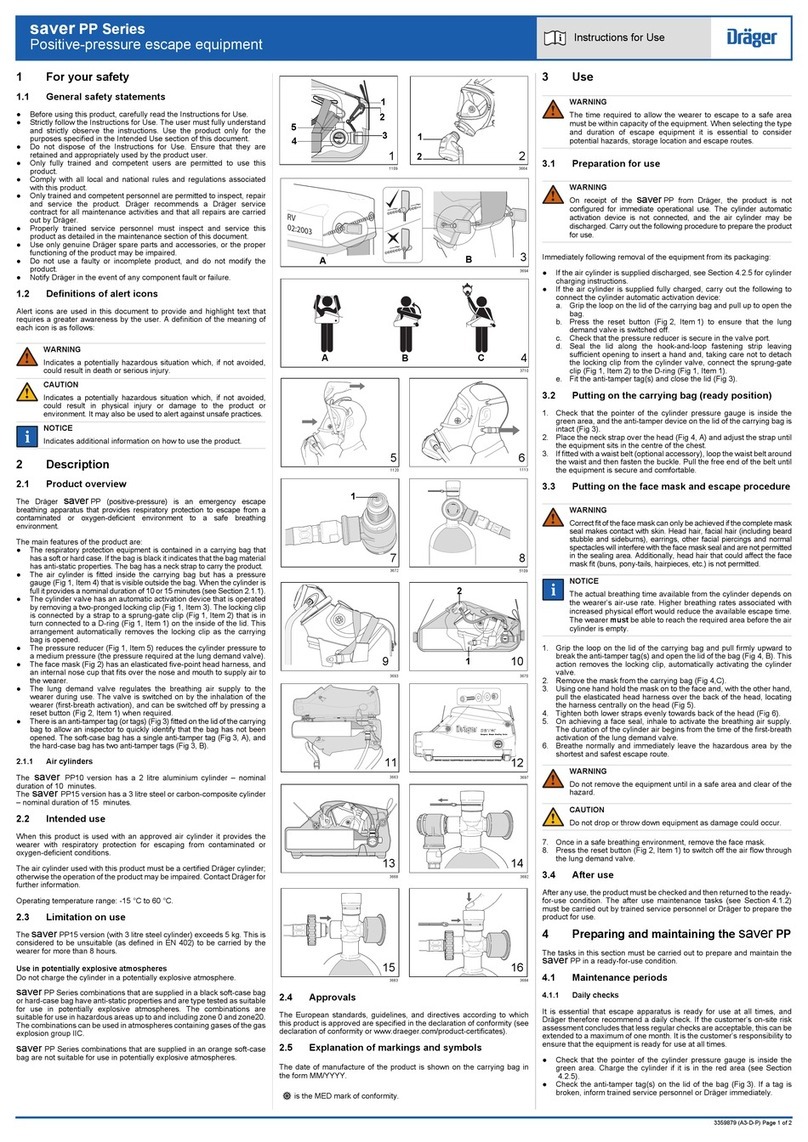
ISTRUZIONI D’USO – USE INSTRUCTIONS –
GEBRAUCHSANLEITUNG – MODE D’EMPLOI -
INSTRUCCIONES PARA EL USO - Οδηγίες Χρήσης-Instruções
para o uso
IST-USO-0906018
Rev. N. 1 del 11/05/2020
IDP107
Pag.7 di 16
DEUTSCH
1. BESCHREIBUNG.
1.1 KAPUZE
Das Air System muss in Kombination mit einer Kapuze des Modells K20 verwendet werden.
1.2 STEUEREINHEIT: Sie besteht aus: einem ABS-Gehäuse mit Buchse; einer von einem
elektrischen Mikromotor betriebenen Lüftergruppe und einer elektronischen
Durchsatzanzeige mit akustischem Alarm.
1.3 SCHLAUCHGRUPPE:
Sie besteht aus einem Schlauch mit einer Spirale, die zwischen zwei glatten Wänden aus
leicht dekontaminierbarem Material eingeschlossen ist.
1.4 AKKUGRUPPE
LI-870: Sie besteht aus: einem aufladbaren, gekapselten Lithium-Akku; einem Gehäuse aus
ABS mit nicht umkehrbarem Stecker; einer Schutzschaltung gegen Kurzschluss- und
Tiefentladung.
1.5 FILTER
ZP3: Die Markierung des Filters mit dem Buchstaben „R“ zeigt an, dass der Staubfilter oder
der Staubschutzteil eines Kombinationsfilters nach der Exposition gegenüber einem
Aerosol für mehr als eine Schicht verwendet werden kann, während die Markierung „NR“
anzeigt, dass die Verwendung auf eine einzige Arbeitsschicht beschränkt ist. Der Filter ZP3
besteht aus fein gefaltetem. mikroporösem, technischem Papier mit nach EN 148-1
genormtem Gewindeanschluss (siehe Gebrauchsanweisung des Filters).
1.6 DURCHSATZANZEIGE:
Elektronisch mit akustischem alarm.
2. TECHNISCHE EIGENSCHAFTEN
2.1 Geräuschpegel: < 75 dB.
2.2 SPEZIFIKATIONEN:
Produktcode
AIR SYSTEM
Minimum erklärt
Luftstrom
[l / min]
Geschätzte
Lebensdauer der
Steuereinheit
h
Nennspannung [V]
Art der
wiederaufladb
aren Batterie
Batterielaufzeit
[h]
Geschätzte
Lebensdauer der
Batterie
0313221 T8X ZP3 160 800 7,4 Lithium
8700 mAh >8
2 Jahre
bzw. 300
Zyklen
3. FUNKTIONSWEISE
Die vom Akku mit Strom versorgte Steuereinheit saugt die Luft durch den Filter an und
schickt sie innerhalb der Kapuze. Der Kapuze gerät in einen leichten Überdruck und der
Arbeiter atmet die filtrierte Luft ein, die durch die Membranventile ausgestoßen wird.
4. GEBRAUCH
4.1 Für den Schutz des Atmungssystems des Arbeiters vor festen und flüssigen
Aerosolen,falls es mit dem Staubfilter ZP3 ausgestattet ist.
Die PSA wurde entwickelt, um die Atemwege, Augen und das Gesicht des Arbeiters
zu schützen.
Einige Anwendungen, für die die PSA zum Schutz der Atemwege konzipiert wurden
gegen feste Aerosole und/oder Flüssigkeiten (mit Filtern ZP3):
Biologisches Risiko (*).
Chemisch und pharmazeutisch: Behandlung mit Pulvern, chemischen Formulierungen
und Spezialpasten.
Dental.
Medizin und Krankenhaus.
Hygiene und lokale Reinigung.
Holzverarbeitung.
Essen und Trinken.
Zellulose und Papier.
Lackierung und Oberflächenbehandlung.
(*) HINWEIS: Dank der Filterung der einströmenden Luft der Klasse P3 schützt das
Gerät den Träger vor COVID19-Kontamination. Die vom Träger ausgeatmete Luft tritt
ohne Filtration durch die Ausatemventile am Kragen aus. Dies bedeutet, dass ein
Träger mit COVID19 die Umgebung kontaminieren kann. Um dieses Risiko zu
vermeiden, sollte zusätzlich zur Kappe eine chirurgische Maske getragen werden. Die
Belüftung in der Motorhaube verhindert das Beschlagen des Bildschirms und macht
das Tragen der PSA angenehmer.
4.2 EINSCHRÄNKUNGEN
a) Nicht in Bereichen mit unmittelbarer Gefahr für Leben und Gesundheit des Arbeiters
verwenden.
b) Nicht als Schutz vor Gasen und Dämpfen verwenden.
c) Nicht als Schutz vor Kohlenmonoxid, Naturgasen und Begasungsmitteln verwenden.
d) Nicht in geschlossenen Räumen verwenden (z.B. Zisternen, Silos).
e) Nicht für Brandrauch verwenden.
f) Nicht in Atmosphären mit einem Sauerstoffgehalt unter 17 % verwenden.
g) Nicht in explosiven Atmosphären verwenden.
h) Nicht gegen gefährlichen Staub verwenden, wenn die Konzentration in der Umgebung
größer als die in der Richtlinie EN 529 vorgesehene ist.
i) Nicht in IDLH-Umgebungen verwenden (unmittelbar gefährliche Situationen für das
Leben oder die Gesundheit des Arbeiters).
5. GEBRAUCHSANWEISUNGEN
5.1 AUFLADEN DES AKKUS
5.1.1 LI-870:
Die aufladbaren Lithium-Akkus dürfen nur mit dem Ladegerät Kasco LI-02 aufgeladen
werden (siehe beiliegende Anweisungen).
DEN AKKU NACH JEDER VERWENDUNG AUFLADEN.
5.2 VORBEREITUNG des Atemschutzgeräts:
5.2.1 STEUEREINHEIT
a) Den Riemen durch den Haken des Akkus und der Steuereinheit durchziehen.
b) Die Akku mit dem Kabel an die Steuereinheit anschließen und mit der Flügelmutter
festziehen, um den Kontakt zu gewährleisten. Sicherstellen, dass das Gerät einwandfrei
funktioniert.
c) Überprüfen, dass die Filterdichtung in der entsprechenden Position untergebracht ist.
5.2.2 FILTER:
a) Vor der Verwendung des Filters überprüfen, dass die Versiegelung unversehrt ist, dass
das Ablaufdatum nicht überschritten wurde und dass der Filter für das Atemschutzgerät,
auf das er montiert wird, geeignet ist.
Darauf achten, nicht die Markierungen auf den
Filtern bezüglich anderer Normen mit der Klassifizierung dieser PSA nach EN 12941:
98+A1/03+A2/08 zu verwechseln.
b) Abdeckungen und/oder Siegel vom Filter entfernen, ihn mit dem Gewinde EN 148-1 an
das vorgesehene Atemschutzgerät anschrauben und die Gebrauchsanweisungen des
Filters durchlesen.
5.3 ANWEISUNGEN FÜR DIE VERWENDUNG UND DIE KONTROLLE DER
DURCHSATZANZEIGEN
a) Überprüfen, dass die Ventile fähig sind, korrekt Luft abzugeben, ansonsten könnten die
Angaben der Anzeiger verfälscht werden.
b) Versichern Sie sich, dass der Akku komplett aufgeladen ist und dass die Filter korrekt
angeschraubt sind.
c) Die nachfolgend angeführten Kontrollen sind NICHT als Kontrollen der Leistung und/oder
der Akkudauer anzusehen.
d) Die Anzeigen ermöglichen, den korrekten Betrieb des Atemschutzgeräts in vertikaler
Position zu überprüfen, indem sie die Verschmutzung des Filters, die Ladung des Akkus,
den Zustand des Motors, die Dichtung und den korrekten Verschluss des Halsriemens .
Wenn Arbeiten ausgeführt werden, bei denen der Arbeiter in geneigter oder horizontaler
Position verharren muss, muss bei einer Verringerung der Luftströmung die vertikale
Position eingenommen werden, um eine Prüfung durchzuführen.
e) Die Anzeigen sind keine universellen Durchsatz-Messinstrumente; ihre Angaben sind
daher nur für den Atemschutzgerätetyp gültig, für den sie geplant und zugelassen sind.
5.3.1 ÜBERPRÜFUNG MIT ELEKTRONISCHER DURCHSATZANZEIGE MIT
AKUSTISCHEM ALARM
a) Überprüfen, dass die Anzeige in senkrechter Stellung ist.
b) Die Steuereinheit in Betrieb setzen und überprüfen, dass die Anzeige eine Sekunde lang
einen Signalton abgibt, der aufhört, sobald der Lüfter der Steuereinheit auf vollen Touren
ist.
c) Anm.: Das Signal muss wiederholt werden, falls der Lüfter beim Ausschalten der
Steuereinheit dazu neigt, stehen zu bleiben.
d) Falls das Signal weiterhin auftritt, überprüfen, ob der Akku leer ist, ob die Filter verstopft
sind, ob der Motor der Steuereinheit nicht den notwendigen Durchsatz gewährleistet oder
ob es im Helm oder im Schlauch Verstopfungen gibt, die das Ausströmen der
ausgehenden Luft verhindern.
5.4 TRAGEN SIE DIE ATEMSCHUTZMASKE:
a) Der Kapuze nur in Umgebung mit sauberer Luft tragen.
b) Den Riemen, auf dem bereits die Steuereinheit, der Filter links und der Akku rechts
angebracht sind, einhaken.
c) Der Kapuze aufsetzen und die Schnur des Halsriemens mit dem Knopf um den Hals
festziehen, bis er möglichst gut schließt. Der Halsriemen darf niemals die Atmung des
Arbeiters behindern. Eventuelle saisonbedingte Kleidungsstücke, die den Hals schützen
sollen, müssen möglichst anliegend sein, um Falten zu vermeiden, die einen Abstand
zum Halsriemen bilden könnten.
6. WARTUNG
6.1 KAPUZE:
a) Waschen Sie der Kapuze mit warmem wasser und Seife reinigen.
b) Das Visier nur mit Wasser und Seife reinigen.
6.2 STEUEREINHEITEN:
a) Der Elektromotor bedarf keinerlei Wartung.
b) Die Steuereinheit mit lösungsmittelfreien Reinigern oder besser mit einem mit einem
Wasser-Äthylalkohol-Gemisch zu gleichen Teilen getränkten Tuch reinigen.
6.3 AKKU:
a) Der Akku bedarf keinerlei Wartung oder Auffüllung.
b) SOFORT NACH JEDER VERWENDUNG AUFLADEN, DAMIT ER MÖGLICHST LANGE
HÄLT.
c) DIE AKKUS DÜRFEN NICHT LEER BLEIBEN. FALLS SIE NICHT FUNKTIONIEREN,
DIE LADUNG, AN DIE SIE ANGESCHLOSSEN SIND, KONTROLLIEREN. DER AKKU
IST MIT EINEM SCHUTZKREISLAUF AUSGESTATTET, DER DIE ZUFUHR
UNTERBRICHT, FALLS EINE LEISTUNG VERLANGT WIRD, DIE DIE GEPLANTE
ÜBERSCHREITET.
d) Wenn der Akku für längere Zeit nicht verwendet werden sollte, vorher zu 50% aufladen
Den Akku nicht länger als sechs Monate vollständig entladen lassen.
6.4 FILTER:
a) Falls sie versiegelt sind, bleiben die Filter bis zum angegebenen Ablaufdatum unversehrt
erhalten.
b) Die Filter, deren Deckel entfernt wurden, müssen in jedem Fall unabhängig von den
Arbeitsstunden innerhalb von DREI Monaten ersetzt werden. Hierzu ist es
empfehlenswert, das Öffnungsdatum auf der Hülle zu vermerken.
c) Die Filter dürfen nicht gewaschen, ausgeblasen oder regeneriert werden. Wenn sie
verbraucht sind, müssen sie ausgewechselt werden.
d) Falls zwei oder mehrere Filter parallel verbunden sind, müssen sie gleichzeitig ersetzt
werden.
Das Atemschutzgerät einmal jährlich bei KASCO oder einem von KASCO befugten
Zentrum kontrollieren lassen.
6.5 PSA-DESINFEKTION GEGEN COVID19:
Sprühen Sie eine Lösung von:
- 70% Ethylalkohol oder
- 0,5% Natriumhypochlorit (entspricht 5000 ppm)
7. HINWEISE
7.1 Das Atemschutzgerät nicht unter den Bedingungen verwenden, von denen unter den
Punkten 4.2 abgeraten wird.
Nicht das Atemschutzgerät verwenden, wenn aus irgendeinem Grund nicht die Kontrolle
des Luftdurchsatzes vorgenommen wurde (siehe Abschnitt 5.3) und / oder wenn die
Durchflussanzeige einen geringen Luftstrom anzeigt (siehe Datentabelle).
7.2 Tauchen Sie die Steuereinheit für Reinigungsvorgänge nicht in Wasser, ohne die
Abgabe und die Absaugung mit den entsprechenden Kappen verschlossen zu haben.
7.3 Den Akku keinen Wärmequellen über 55°C aussetzen.
Die Kontakte des Akkus nicht kurzschließen.
Den Akku nicht in Kontakt mit stark vibrierenden Teilen lassen.
Falls der Akku kaputt gehen sollte, die damit in Berührung geratenen Teile sofort mit
Wasser waschen.
Den Akku möglichst wenig ultravioletten oder Infrarot-Strahlen aussetzen.
Den Akku nicht durchbohren, quetschen, zerlegen oder öffnen, da das austretende
Material sich entzünden, explodieren oder gefährliche Stoffe abgeben könnte.
Das Ladegerät nur am Akku angeschlossen lassen, wenn das Ladegerät mit Strom
versorgt wird.
Der Akku wird nur bei einer Temperatur zwischen 0° und 40°C korrekt aufgeladen.
7.4 Niemals abgelaufene Filter verwenden, auch, wenn die Siegel unversehrt sind.
